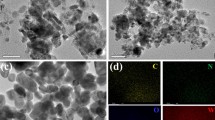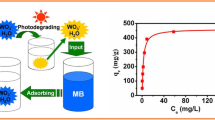Abstract
Novel metastable h-WO3 nano-hemitubes have been controllably prepared on a large scale assisted by inorganic structure directing agent of (NH4)2C2O4 through a convenient and facile hydrothermal route. The chemical composition, morphology, crystal structure, surface area and optical property of as-obtained products were investigated using various characterization techniques. Interestingly, it was found that the introduction and the adding amount of (NH4)2C2O4 played an important role in the process of controlling the phase and morphology of WO3. An appropriate amount of (NH4)2C2O4 (10–14 mmol) was beneficial for inducing the formation of metastable h-WO3 nano-hemitubes. However, monoclinic m-WO3 square-shaped nanoplates were obtained by adding 2 mmol (NH4)2C2O4. The results of photoluminescence (PL) test demonstrated that h-WO3 nano-hemitubes has a lower recombination rate of photogenerated electron–hole pairs and a longer lifetime of photogenerated carriers. Due to the special structure, the prepared one-dimensional h-WO3 nano-hemitubes displayed very superior adsorption–photocatalysis–oxidation activity for removing MB from highly concentrated MB-containing wastewater, which was 6.1 times higher than that of two-dimensional monoclinic m-WO3 square-shaped nanoplates. The mechanism of adsorption–photocatalysis–oxidation degradation for MB on h-WO3 nano-hemitubes was simply proposed. The prepared h-WO3 nano-hemitubes may have a potential application in wastewater purification and environmental remediation.








Similar content being viewed by others
References
I. Khan, A. Jalilov, K. Fujii, A. Qurashi, Quasi-1D aligned nanostructures for solar-driven water splitting applications: challenges, promises, and perspectives. Solar RRL. 5, 2000741 (2021). https://doi.org/10.1002/solr.202000741
H.S. Han, W. Park, A. Sivanantharm, S.W. Hwang, S. Surendran, U. Sim, I.S. Cho, Facile fabrication of nanotubular heterostructure for enhanced photoelectrochemical performance. Ceram. Int. 47, 3972–3977 (2021). https://doi.org/10.1016/j.ceramint.2020.09.261
L. Vichard, N.Y. Steiner, N. Zerhouni, D. Hissel, Hybrid fuel cell system degradation modeling methods: a comprehensive review. J. Powder Sour. 506, 230071 (2021). https://doi.org/10.1016/j.jpowsour.2021.230071
D.K. Lee, S.J. Wee, K.J. Jang, M.K. Han, S. Surendran, S.Y. Cho, J.Y. Kim, S.K. Lee, U. Sim, 3D-printed cobalt-rich tungsten carbide hierarchical electrode for efficient electrochemical ammonia production. J. Korean Chem. Soc. 58, 679–687 (2021). https://doi.org/10.1007/s43207-021-00142-4
J.W. Fu, K. Liu, H.M. Li, J.H. Hu, M. Liu, Bimetallic atomic site catalysts for CO2 reduction reactions: a review. Environ. Chem. Lett. 20, 243–262 (2022). https://doi.org/10.1007/s10311-021-01335-3
L. Yao, H. Yang, Z.S. Chen, M.Q. Qiu, B.W. Hu, X.X. Wang, Bismuth oychloride-based materials for the removal of organic pollutants in wastewater. Chemosphere 273, 128576 (2021). https://doi.org/10.1016/j.chemosphere.2020.128576
D. Vaya, P.K. Surolia, Semiconductor based photocatalytic degradation of pesticides: an overview. Environ. Technol. Inno. 20, 101128 (2020). https://doi.org/10.1016/j.eti.2020.101128
Y.J. Li, H.R. Dong, L. Li, L. Tang, R. Tian, R. Li, J. Chen, Q.Q. Xie, Z.L. Jin, J.Y. Xiao, Recent advances in waste water treatment through transition metal sulfides-based advanced oxidation processes. Water Res. 192, 116850 (2021). https://doi.org/10.1016/j.watres.2021.116850
G. Zeng, M.H. Duan, J. He, F.H. Ge, W.G. Wang, Sulfate doped graphitic carbon nitride with enhanced photocatalytic activity towards degradation of methylene blue. Mater. Lett. 309, 131310 (2022). https://doi.org/10.1016/j.matlet.2021.131310
S. Balaji, Y. Djaoued, A.S. Albert, R. Bruening, N. Beaudoin, J. Robichaud, Porous orthorhombic tungsten oxide thin films: synthesis, characterization, and application in electrochromic and photochromic devices. J. Mater. Chem. 21, 3940–3948 (2011). https://doi.org/10.1039/C0JM03773G
T. He, J. Yao, Photochromic materials based on tungsten oxide. J. Mater. Chem. 17, 4547–4557 (2007). https://doi.org/10.1039/B709380B
Martinez D. Sanchez, A. Martinez-de la Cruz, E. Lopez Cuellar, Photocatalytic properties of WO3 nanoparticles obtained by precipitation in presence of urea as complexing agent. Appl. Catal. A 398, 179–186 (2011). https://doi.org/10.1016/j.apcata.2011.03.034
J.S. Lee, O.S. Kwon, D.H. Shin, J. Jang, WO3 nanonodule-decorated hybride carbon nanofibers for NO2 gas sensor application. J. Mater. Chem. 1, 9099–9106 (2013). https://doi.org/10.1039/C3TA11658A
F. Zheng, J. Wang, W.B. Liu, J.M. Zhou, H. Li, Y. Yu, P.F. Hu, W. Yan, Y. Liu, R. Li, Q. Zhen, J.J. Zhang, Novel diverse-structured h-WO3 nanoflake arrays as electrode materials for high performance supercapacitors. Electrochim. Acta 334, 135641 (2020). https://doi.org/10.1016/j.electacta.2020.135641
H.S. Han, W. Park, S.W. Hwang, H. Kim, Y. Sim, S. Surendran, U. Sim, I.S. Cho, (020)-Textured tungsten trioxide nanostructure with enhanced photoelectrochemical activity. J. Catal. 389, 328–336 (2020). https://doi.org/10.1016/j.jcat.2020.06.012
M. Hibino, W. Han, T. Kudo, Electrochemical lithium intercalation into a hexagonal WO3 framework and its structural change. Solid State Ion. 135, 61–69 (2000). https://doi.org/10.1016/S0167-2738(00)00332-5
M.J. Liao, L. Su, Y.C. Deng, S. Xiong, R.D. Tang, Z.B. Wu, C.X. Ding, L.H. Ynag, D.X. Gong, Strategies to improve WO3-based photocatalysts for wastewater treatment: a review. J. Mater. Sci. 56, 14416–14447 (2021). https://doi.org/10.1007/s10853-021-06202-8
D.P. DePuccio, P. Botella, B. O’Rourte, C.C. Landry, Degradation of methylene blue using porous WO3, SiO2-WO3, and their Au-loaded analogs: adsorption and photocatalytic studies. ACS Appl. Mater. Interfaces. 7, 1987–1996 (2015). https://doi.org/10.1021/am507806a
J.Y. Luo, Z. Cao, F. Chen, L. Li, Y.R. Lin, B.W. Liang, Q.G. Zeng, M. Zhang, X. He, C. Li, Strong aggregation adsorption of methylene blue from water using amorphous WO3 nanosheets. Appl. Surf. Sci. 287, 270–275 (2013). https://doi.org/10.1016/j.apsusc.2013.09.139
F. Wang, C.H. Li, J. Yu, Hexagonal tungsten trioxide nanorods as a rapid adsorbent for methylene blue. Sep. Purif. Technol. 91, 103–107 (2012). https://doi.org/10.1016/j.seppur.2011.12.001
T.M. Salama, M. Morsy, R.M.A. Shahba, S.H. Mohamed, M.M. Mohamed, Synthesis of graphene oxide interspersed in hexagonal WO3 nanorods for high-efficiency visible-light driven photocatalysis and NH3 gas sensing. Front. Chem. 7, 722 (2019). https://doi.org/10.3389/fchem.2019.00722
X. Liu, A.L. Jin, Y.S. Jia, T.L. Xia, C.X. Deng, M.H. Zhu, C.F. Chen, X.S. Chen, Synergy of adsorption and visible-light photocatalytic degradation of methylene blue by a bifunctiobal Z-scheme heterojuncyion of WO3/g-C3N4. Appl. Surf. Sci. 405, 359–371 (2017). https://doi.org/10.1016/j.apsusc.2017.02.025
D.F. Wu, X.X. Su, W.W. Guo, Enhanced photocatalytic degradation of methylene blue over hexagonal WO3/graphene under visiblr-light irradiation. Kinet. Catal. 58, 710–719 (2017). https://doi.org/10.1134/S0023158418010159
Y.S. Li, M.R. Ti, Z.Q. Li, Y. Zhang, L. Wu, Y.J. He, Comparative study on the removal of different-type organic pollutants on three-dimensional hexagonal-tungsten trioxide/reduced graphene oxide nanorod arrays: adsorption and visible light photodegradation. J. Mater. Sci.-Mater. Electron. 32, 2268–2282 (2021). https://doi.org/10.1007/s10854-020-04991-3
S. Nakakura, A.F. Arif, F.G. Rinaldi, T. Hirano, E. Tanabe, R. Balgis, T. Ogi, Direct synthesis of highly crystalline single-phase hexagonal tungsten oxide nanorods by spray pyrolysis. Adv. Powder Technol. 30, 6–12 (2019). https://doi.org/10.1016/j.apt.2018.09.040
D. Zhang, Y. Fan, G.J. Li, Z.H. Ma, X.H. Wang, Z.X. Cheng, J.Q. Xu, Highly sensitive BTEX sensors based on hexagonal WO3 nanosheets. Sensor. Actuat. B-Chem. 293, 23–30 (2019). https://doi.org/10.1016/j.snb.2019.04.110
Y.L. Wang, X.L. Wang, Y.H. Li, L.J. Fang, J.J. Zhao, X.L. Du, A.P. Chen, H.G. Yang, Controllable synthesis of hexagonal WO3 nanoplates for efficient visible-light-driven photocatalytic oxygen production. Chem.-Asian J. 12, 387–391 (2017). https://doi.org/10.1002/asia.201601471
K. Huang, Q. Zhang, Rechargeable lithium battery based on a single hexagonal tungsten trioxide nanowires. Nano Energy 1, 172–175 (2012). https://doi.org/10.1016/j.nanoen.2011.08.005
C. Lian, X.L. Xiao, Z. Chen, Y.X. Liu, E.Y. Zhao, D.S. Wang, C. Chen, Y.D. Li, Preparation of hexagonal ultrathin WO3 nano-ribbons and their electrochemical performance as an anode material in lithium ion batteries. Nano Res. 9, 435–441 (2016). https://doi.org/10.1007/s12274-015-0924-6
X.G. San, Y.M. Lu, G.S. Wang, D. Meng, X.H. Gong, Q. Jin, In situ growth of WO3 nanotube arrays and their H2S gas sensing properties for reduced operating temperature. Mater. Lett. 271, 127716 (2020). https://doi.org/10.1016/j.matlet.2020.127716
Z.J. Gu, T.Y. Zhai, B.F. Gao, X.H. Sheng, Y.B. Wang, H.B. Fu, Y. Ma, J.N. Yao, Controllable assembly of WO3 nanorods/nanowires into hierarchical nanostructures. J. Phys. Chem. B. 110, 23829–23836 (2006). https://doi.org/10.1021/jp065170y
J.R.G. Navarro, A. Mayence, J. Andrade, F. Lerouge, F. Chaput, P. Oleynikov, L. Bergstrom, S. Parola, A. Pawlicka, WO3 nanorods created by self-assembly of highly crystalline nanowires under hydrothermal conditions. Langmuir 30, 10487–10492 (2014). https://doi.org/10.1021/la5025907
K. Huang, Q. Zhang, F. Yang, D.Y. He, Ultraviolet photoconductance of a single hexagonal WO3 nanowire. Nano Res. 3, 281–287 (2010). https://doi.org/10.1007/s12274-010-1031-3
I.M. Szilagyi, J. Madarasz, G. Pokol, P. Kiraly, G. Tarkanyi, S. Saukko, J. Mizsei, A.L. Toth, A. Szabo, K. Varga-Josepovitso, Stability and controlled composition of hexagonal WO3. Chem. Mater. 20, 4116–4125 (2008). https://doi.org/10.1021/cm800668x
L. Chen, S. Lam, Q.H. Zeng, R. Amal, A.B. Yu, Effect of cation on the growth of hexagonal WO3 nanorods. J. Phys. Chem. C. 116, 11722–11727 (2012). https://doi.org/10.1021/jp301210q
K. Sayama, H. Hayashi, T. Arai, M. Yanagida, T. Gunji, H. Sugihara, Highly active WO3 semiconductor photocatalyst prepared from amorphous peroxo-tungstic acid for the degradation of various organic compounds. Appl. Catal. B: Environ. 94, 150–157 (2010). https://doi.org/10.1016/j.apcatb.2009.11.003
T. Tauc, T.A. Scott, The optical properties of solids. Phys. Today. 20, 105–106 (1967). https://doi.org/10.1063/1.3033945
A. Sonia, Y. Djaoued, B. Subramanian, R. Jacques, M. Eric, B. Ralf, B. Achour, Synthesis and characterization of novel nanorod superstructures and twin octahedral morphologies of WO3 by hydrothermal treatment. Mater. Chem. Phys. 136, 80–89 (2012). https://doi.org/10.1016/j.matchemphys.2012.06.034
L.J. Zhang, S. Li, B.K. Liu, D.J. Wang, T.F. Xie, Highly efficient CdS/WO3 photocatalysts: Z-scheme photocatalytic mechanism for their enhanced photocatalytic H2 evolution under visible light. ACS Catal. 4, 3724–3729 (2014). https://doi.org/10.1021/cs500794j
Y.S. Fan, X.L. Xi, Y.S. Liu, Z.R. Nie, L.Y. Zhao, Q.H. Zhang, Regulation of morphology and visible light-driven photocatalysis of WO3 nanostructures by changing pH. Rare Met. 40, 1738–1745 (2021). https://doi.org/10.1007/s12598-020-01490-6
S. Jeon, K. Yong, Morphology-controlled synthesis of highly adsorptive tungsten oxide nanostructures and their application to water treatment. J. Mater. Chem. 20, 10146–10151 (2010). https://doi.org/10.1039/C0JM01644F
M. Farjood, M.A. Zanjanchi, Template-free synthesis of mesoporous tungsten oxide nanostructures and its application in photocatalysis and adsorption reactions. ChemistrySelect 4, 3042–3046 (2019). https://doi.org/10.1002/slct.201804007
A.H. Nethercot, Prediction of Fermi energies and photoelecctric thresholds based on electronegativity concepts. Phys. Rev. Lett. 33, 1088–1091 (1974). https://doi.org/10.1103/PhysRevLett.33.1088
L.Q. Ye, Y.R. Su, X.L. Jin, H.Q. Xie, C. Zhang, Recent advances in BiOX (X= Cl, Br and I) photocatalysts: synthesis, modification, facet effects and mechanisms. Environ. Sci. 1, 90–112 (2014). https://doi.org/10.1039/C3EN00098B
P.Y. Dong, G.H. Hou, X. Xi, R. Shao, F. Dong, WO3-based photocatalysts: morphology control, activity enhancement and multifunctional applications. Environ. Sci. 4, 539–557 (2017). https://doi.org/10.1039/C6EN00478D
D.Q. Bi, Y.M. Xu, Synergism between Fe2O3 and WO3 particles: photocatalytic activity enhancement and reaction mechanism. J. Mol. Catal. A 367, 103–107 (2013). https://doi.org/10.1016/j.molcata.2012.09.031
R. Abe, H. Takami, N. Murakami, B. Ohtani, Pristine simple oxides as visible light driven photocatalysts: highly efficient decomposition of organic compounds over platinum-loaded tungsten oxide. J. Am. Chem. Soc. 130, 7780–7781 (2008). https://doi.org/10.1021/ja800835q
D.Q. Bi, Y.M. Xu, Improved photocatalytic activity of WO3 through clustered Fe2O3 for organic degradation in the presence of H2O2. Langmuir 27, 9359–9366 (2011). https://doi.org/10.1021/la2012793
J. Pan, J. Liu, S. Zuo, U.A. Khan, Y. Yu, B. Li, Synthesis of cuboid BiOCl nanosheets coupled with CdS quantum dots by region-selective deposition process with enhanced photocatalytic activity. Mater. Res. Bull. 103, 216–224 (2018). https://doi.org/10.1016/j.materresbull.2018.03.043
Acknowledgements
This work was supported by the Open Foundation of Anhui Province Key Laboratory of Advanced Building Materials (JZCL002KF), the Key Projects of Support Program for Outstanding Young Talents in Colleges and Universities of Anhui Province (gxyqZD2016151) and the Natural Science Foundation of Anhui Educational Committee (KJ2014ZD08).
Author information
Authors and Affiliations
Corresponding authors
Additional information
Publisher's Note
Springer Nature remains neutral with regard to jurisdictional claims in published maps and institutional affiliations.
Rights and permissions
About this article
Cite this article
Hu, H., Ding, K., Yu, H. et al. Metastable h-WO3 nano-hemitubes: controllable synthesis and superior adsorption–photocatalysis–oxidation activity for high-concentrated MB. J. Korean Ceram. Soc. 60, 227–237 (2023). https://doi.org/10.1007/s43207-022-00211-2
Received:
Revised:
Accepted:
Published:
Issue Date:
DOI: https://doi.org/10.1007/s43207-022-00211-2




